Your cart is currently empty!
Potter’s Wheel History | How Ancient Pottery Wheels Evolved
Published:
Last Updated:
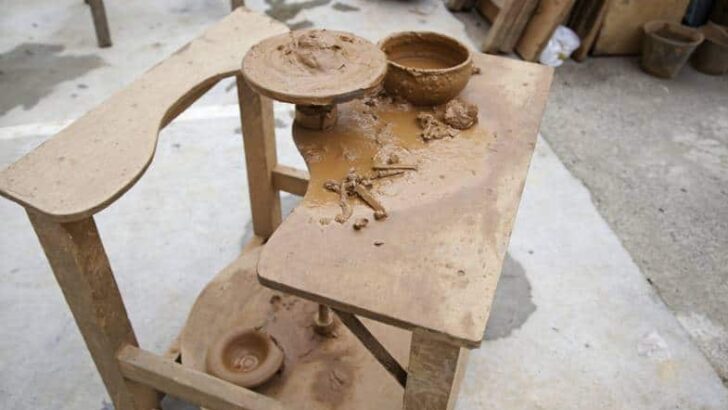
Affiliate Disclaimer
As an affiliate, we may earn a commission from qualifying purchases. We get commissions for purchases made through links on this website from Amazon and other third parties.
The potter’s wheel as we know it today has been on a long journey over 1000’s of years. It has developed from the most basic form of rotating device to the electrical pottery wheels, most potters use now. But exactly how and where did these changes take place, and what exactly is the potter’s wheel history?

Ancient Pottery Techniques
Humans have been making pottery for many thousands of years. The earliest techniques for making pots included coiling, pinching, and paddling clay into shape. All these methods of making pottery pre-date the invention of the pottery wheel.
Coil pottery is often cited as the oldest method of hand-building pottery. There are different methods of making coil pottery. However, in its simplest form, making a coil pot involves rolling or squeezing out a coil of clay.
The coil can then be made into a spiral and blended together to form the base of a pot. Or the base can be made out of a flattened disc of clay.
The walls of the pot are then built up by adding coils of clay to the rim of the base. As the coils are added the clay is blended together to give the pot strength. The surface of the pot is smoothed out using a combination of fingers or pottery implements.
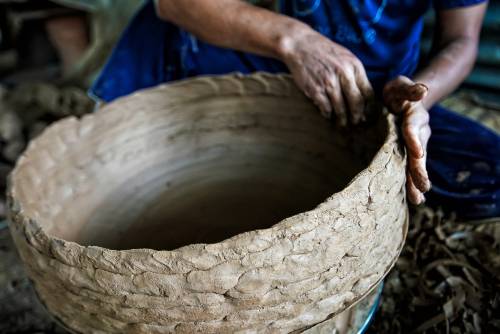
There is evidence of pottery being made using a method like in different corners of the globe.
For example, it’s thought that the Jomon Pottery of Japan was first made around 14500BC (source). In Africa, it’s thought that pottery started to be made around 7000 or 6000BC. And, there is evidence of coil pottery having been made in Central Mexico around 2000BC.
So, hand-building pottery, particularly through coiling has a long-established history across the globe.
The Emergence of the Potter’s Wheel
The potter’s wheel as we know it today is very different from these ancient coiling techniques. Nevertheless, electric pottery wheels have developed out of more primitive ways of making pottery.
One of the features of the potter’s wheel is that it rotates the clay so that the potter can shape it.
The development of the wheel is a story of how the wheel comes to rotate faster and with more power and efficiency. This story takes place over thousands of years.
So, how does the story start? It starts with what archeologists call the simple ‘rotary device’ (source). Let’s take a look at what a rotary device is and how it was the start of the potter’s wheel history.
The Rotary Device
Primitive potters found that coiling clay was easier if they place the base of the pot onto a surface that would be rotated. Often the pot would be put onto a leave, mat, old pottery sherd, or a specially made concave plate.
Putting the soft fresh clay onto a movable surface meant that the potter could turn the coil pot with ease.
This meant that they could either sit or stand and make the pot, without having to move around to add the coils. Instead, the pot would rotate and they would add and blend in the coils as the pot turned.
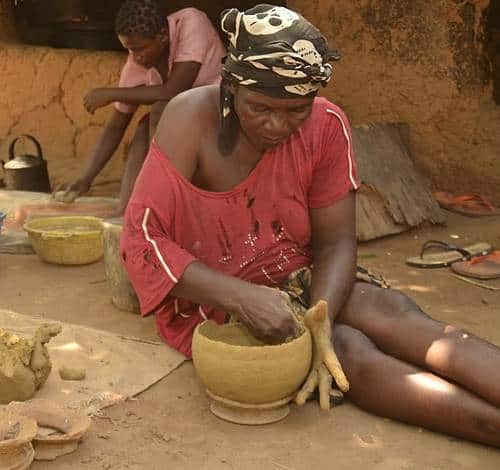
Image is cropped
It’s thought that simple rotary devices of this kind started to be used around 5000BC in an area known as the Near East. Scholars and journalists now refer to the Near East as the Middle East (source).
The rotary device was a useful starting point in the potter’s wheel history. However, around 4200 to 4000BC the first thing really resembling a pottery wheel started to be used. These are now referred to a ‘turntables’ or ‘tournettes’.
The Potter’s Turntable
Turntables are similar to what modern-day potters call banding wheels. A turntable is a flat round disc that is mounted on an axis. The axis allows the turntable to rotate on a supportive base.
Early turntables were made from wood, clay, or stone. They were not very free turning and did not rotate especially easily.
However, over time, the design of the turntable improved. For example, a basic turntable would involve a shaped stone with a pointed axis resting in a supporting stone. But as time went on, potters started to use shafts, pivots, and bearings to allow the turntable to rotate more easily.
The Development of the Turntable
There is evidence of turntables being used in different areas of the world. For example, there are paintings on tombstones in ancient Egypt that span over 2000 years. These paintings indicate various different designs of turntables being used over the years. (source)

It’s thought that the earliest use of the turntable dates back to around 4000BC in Southern Iraq. This region was historically known as Mesopotamia and included the cities of Ur, Uruk, Ubaid, and Eridu.
Each of these cities was the seat of a growing sophisticated civilization called the Sumer civilization, with a vibrant trading culture. For this reason, the Sumerians are often said to have invented the potter’s wheel.
Interestingly, the use of the wheel as a potters turntable happened earlier in history than the use of the wheel for transport. The potter’s turntable was already an established pottery technique before ‘the wheel’ was invented for carts and wagons (source).
In fact, the first wheeled vehicles are thought to have appeared in Europe and Asia around 3500-3350BC (source). So, the potter’s wheel really was ahead of its time.
Although turntables were a big advance on the rotary device, potter’s still used the coiling method to build pots. The turntable simply allowed them to add coils faster and to hand build pots more quickly.
But the potter’s wheel history was about to make another huge leap forward with the invention of the flywheel. So, let’s take a look at what happened to the potter’s wheel when the flywheel came on the scene.
The Potter’s Wheel
Around 3000BC the potter’s turntable was adapted and became closer to what we think of as the potter’s wheel today. This adaptation involved the use of a flywheel.
The principle of the flywheel is that a spinning wheel stores energy and will continue to spin through its own momentum. The term for this is ‘rotational kinetic energy’.
Kinetic energy is the energy an object has due to its motion. And not surprisingly, rotational kinetic energy is the energy it has due to the rotation of an object.
- The flywheel on a potter’s wheel makes use of this storage of energy. Once a flywheel is turning, it will continue to spin for a long time. This is true even if pressure is being applied to it from the outside. For example, the pressure of a potter’s hands shaping clay (source).
- Because these potter’s wheels rely on the momentum of the spinning flywheel, they are sometimes called ‘momentum wheels’.
- One advantage of this is that both of the potters hands are free to work on their pot.
Flywheel potter’s wheels can be divided into two categories they are, they are:
- Simple wheels
- Double wheels
Let’s take a look at the difference between these two…
Simple Wheels
Simple wheels use only one large, heavy wheel. This single wheel is both the flywheel and also the surface on which the potter makes their pots.
Usually, simple wheels are close to the ground. The potter will either sit or squat by the wheel and shape the clay as the wheel turns.
The flywheel is set in motion using a stick. There are notches along the edge of the flywheel. A stick is inserted into one of the notches and the stick is pulled towards the potter. This sets the flywheel in motion.
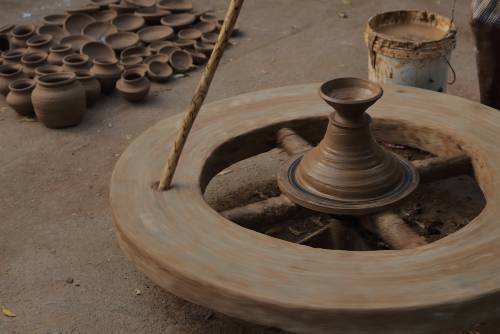
Most pottery wheels turn anti-clockwise. However, the simple wheel usually turns clockwise. This is because most people are righthanded and it’s easier to pull the stick towards yourself with your dominant hand.
Simple wheels are typically used in Japan, China and Indian. This is cited as being a reason why many potter’s wheels in these countries turn clockwise, unlike most other countries. (F, Hamer. and J, Hamer. 2015 p.398).
The stick is either pulled by the potter themselves, or they might have an assistant to do this job.
Double Wheels
On a double wheel, the wheel head and flywheel are separate. With a double wheel, the wheel head is smaller and lighter.
In fact, the wheel head is usually raised off the ground and attached to the end of a shaft. The other end of the shaft is attached to a large heavy flywheel which is situated close to the ground.
The oldest form of the double wheel is the kick wheel. Since its invention, there have been more modern developments of the kick wheel, which we will take a look at later. But for now, let’s take a closer look at how the kick wheel works…
The Kick Wheel
As described above, on a kick wheel, the wheel head is raised from the ground and level with the potter’s hands when they are sitting down. Normally the seat was an integrated part of the wheel.
The heavy flywheel was directly beneath the potter’s feet, and they would start the flywheel turning by kicking it. It takes a few kicks to get the flywheel turning fast enough. However, once it is turning, the wheel head, which is attached to the other end of the shaft, turns quickly.
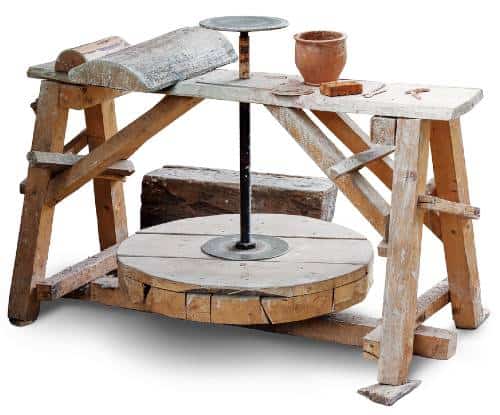
Some potters prefer to use kick wheels today as a preference to using an electric wheel.
These days kick wheels usually have a splash pan to collect trimmings and slip that come of the pot as it’s being made. However, originally there was no splash pan. Sometimes a sheet of leather was stretched out by the kick wheel to catch the debris.
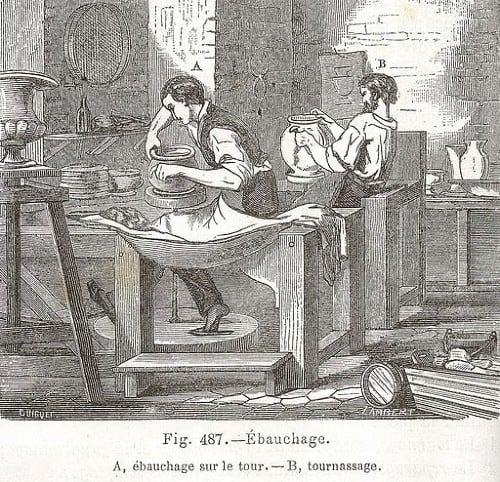
There are a number of accounts of where the kick wheel was first invented. For example, remains of a stone potter’s wheel have been found in the Sumerian city of Ur, in Mesopotamia (now present-day Iraq). This has been dated back to around 3129BC (source).
However, others believe that the flywheel was first used on the potter’s wheel in Egypt around 3000BC. (F, Hamer. and J, Hamer. 2015. p. 398).
Other sources suggest that the kick wheel was first used in China or southeastern Europe (source). So, it’s hard to say exactly where the kick wheel was first invented.
Nevertheless, what we do know, is that the kick wheel remained the main way of making pottery until the invention of the electric pottery wheel in the 1900s.
Other Types of Double Wheel
Other manual momentum wheels include the Treadle wheel. This type of pottery wheel was invented in the first half of the 20th century by Dicon Nance.
Nance worked for Bernard Leach at the Leach Pottery in St Ives, Cornwall, UK, where he made pottery wheels (source).
Unlike the kick wheel, the potter does not kick the flywheel on a treadle wheel. Instead, the flywheel is moved by a treadle bar. The potter gently swings the treadle bar back and forward.
The treadle bar is attached to a crankshaft, which moves as the potter operates the bar. The crankshaft is attached to the flywheel, and as the crank moves, the flywheel turns.
This then creates a smooth rotational movement in the wheel head above. So instead of having to kick the heavy flywheel, the potter moves the treadle bar easily with their foot.
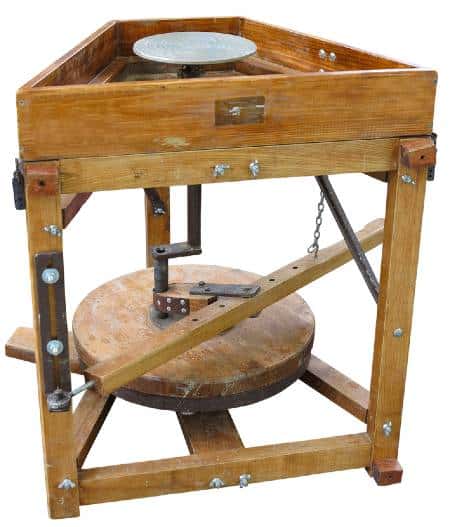
There are other types of manual potters wheels that are operated with a foot bar. The bar is a little like the pedal design on an old industrial pre-electric sewing machine.
To operate the wheel the potter would push the bar back and forward with their foot. The bar is attached to a crankshaft, which in turn is attached to the main shaft. This main shaft runs up from the foot bar towards the wheel head.
As the potter moves their foot back and forwards the wheel head turns.
Fast and Slow Potter’s Wheels
To summarize the above, the potter’s wheel history is often thought to have developed as follows:
- The simple rotary device
- The potter’s turntable
- Simple pottery wheels
- Double pottery wheels
The rotary device and turntable, are often referred to as ‘slow wheels’. And the simple and double wheels, which both use a flywheel, are referred to as ‘fast wheels’.
In fact, it’s generally thought that slow wheels are not really potter’s wheels. The invention of the potter’s wheel usually refers to the invention of the fast wheel.
One reason for this is that slow wheels are typically associated with the coiling technique. Whereas fast wheels are associated with what we now call ‘thrown’ pottery.
Coiling V’s Throwing Pottery
‘Throwing’ pottery refers to using both hands to shape the clay as it turns on the wheel head. The potter uses water and clay slip to make the clay slippery. Then they use a combination of centrifugal force and the pressure and shape of their hands to shape the clay.
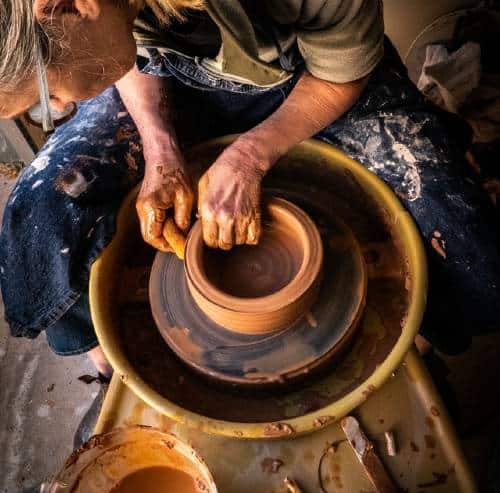
It’s understandable to assume that when the fast wheel was invented that potters immediately adopted the throwing technique.
However, this is not necessarily what happened. In fact, it took many years for wheel throwing to be adopted after fast wheels were invented.
For a long time, the fast potter’s wheel was used to make coil pots more quickly. Larger, longer coils could be added to pottery more efficiently.
In fact, the fast wheel was used in a couple of ways to make coil pottery. The first technique was to make a coil pot and then use the wheel to thin and smooth the pot out. The second, more difficult technique, involved adding the coils to the pot as the wheel head rotated.
Either way, throwing as we understand it today did not emerge until the fast wheel had been in use for some years.
This is because the ‘throwing’ technique had yet to be discovered. Potters simply didn’t know that they could use the rotational kinetic energy of the wheel to shape the clay. They also had to develop a whole new set of motor skills. And anyone who has learned how to throw pots on a potter’s wheel knows that this takes time!
The Potter’s Wheel History – A Mixed Bag
There are different accounts of where and when the potter’s wheel was first invented. However, archeology seems to indicate that it first emerged in the middle east.
It then spread across the Mediterranean into southern and eastern Europe. This occurred during the Late Bronze and Early Iron Age (source).
It then spread through Asia and eventually, the fast wheel arrived in the Americas with the Spanish in the 15th century.
However, its progress in history is not simple. For example, in some regions, the potter’s wheel was ‘discovered’ and used for centuries. Then the technology would be ‘lost’ as cultures and civilizations died out or were replaced.
An example of this occurred in the historical region of the southern Levant. This region refers today to Israel, Palestine, and Jordan.
Between 4500 and 4000 BC, the potter’s wheel was used by the Chalcolithic culture in the Levant. However, the wheel was only used by a select number of craftspeople, and the items made were for the social elite.
As history progressed, the social elite in the Levant collapsed, and the skills and technology of the potter’s wheel disappeared with them.
It wasn’t until 1500 BC that the potter’s wheel reappeared permanently in the Levant region (source)
In other regions such as Crete, the potter’s wheel was used by the wider population, not just the elite. So, the wheel continued to be used, even when there were big cultural changes.
So, the potter’s wheel history varies from region to region and is not always a straightforward journey.
Final Thoughts
In many ways, the potter’s wheel seems like a humble invention. Making pottery, is after all, about shaping mud.
However, a brief look at the potter’s wheel history shows what an influential piece of technology it really has been. The potter’s wheel was in use well before wheels were seen on vehicles. And it was the first way that the flywheel was used in manufacturing. In many ways, it used pioneering technology.



